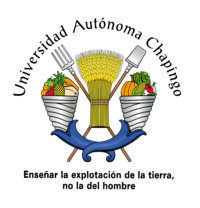Chapingo Autonomous University
| Universidad Autónoma Chapingo | |

Chapingo Autonomous University seal (Unofficial)
|
|
|
Former names
|
Escuela Nacional de Agricultura (National School of Agriculture, 1854) |
|---|---|
| Motto | Spanish: Enseñar la explotación de la tierra, no la del hombre |
|
Motto in English
|
To teach the exploitation of the land, not the exploitation of the men. |
| Type | Public university |
| Established | 22 February 1854 |
|
Academic staff
|
1,254 (2017) |
| Students | 9,493 (2017) |
| Undergraduates | 5,203 (2017) |
| Postgraduates | 597 |
|
Other students
|
3,693a (2017) |
| Location |
Chapingo (municipality of Texcoco, Mexico State), State of Mexico, Mexico 19°29′23″N 98°53′37″W / 19.489644°N 98.893551°WCoordinates: 19°29′23″N 98°53′37″W / 19.489644°N 98.893551°W |
| Campus | Rural |
| Colors | Blue and silver |
| Nickname | Wild Bulls |
| Website | http://www.chapingo.mx/ |
|
a This university has high school education. |
|
a This university has high school education.
Universidad Autónoma Chapingo (Chapingo Autonomous University) is an agricultural college located in Texcoco, Mexico State in Mexico. The university is a federally funded public institution of higher education. It offers technical and full bachelor's degrees as well as having scientific and technological research programs. Many of these programs are related to agriculture, forestry and fishing.
The school began as the Escuela Nacional de Agricultura (National School of Agriculture) which was founded in 1854 at the Monastery of San Jacinto in Mexico City. The school was moved in 1923 to the President Álvaro Obregón ex Hacienda of Chapingo. Postgraduate studies were added in 1959. The school received autonomous status in 1978. It offers courses of study in Forestry, Agricultural Economics, Agricultural Industries, Irrigation, Rural Sociology and more.
The main attraction for visitors at this school is its murals. In the old hacienda chapel, which is now the University Ceremonies Room is a mural by Diego Rivera called “Tierra Fecundada” (Fertile Land). This work was begun in 1924 and completed in 1927. Covering an area of over 700m2, the work divides into three parts. The left panel depicts man’s struggle to have land, the right panel shows the evolution of Mother Nature and the center shows the communion between man and earth. It is considered to be one of Rivera’s best works. More recently, the school acquired an unnamed mural by Luis Nishizawa. This work was produced during his last year at the Escuela Nacional de Artes Plasticas (ENAP) of UNAM and depicts the agriculture of Mexico in both the past and the present. The work is six meters high, nine meters wide and in the form of a triangle. It is placed in a building that is commonly called “El Partenon.”
The school is also home to the National Museum of Agriculture. The 2,000 m2 facility presents the development of agriculture in Mexico from the pre-Hispanic past to the present day. The collection has about 4,000 objects relating to technology, agronomy including farming implements and photographs by Hanz Gutmann.
The university offers high school education to its students before they choose a bachelor, the Agricultural Preparatory takes three years to finish and for students that already have a high school education, a one year Propaedeutic course is mandatory. The purpose is to prepare the students for the agricultural focused bachelors the university offers.
...
Wikipedia
